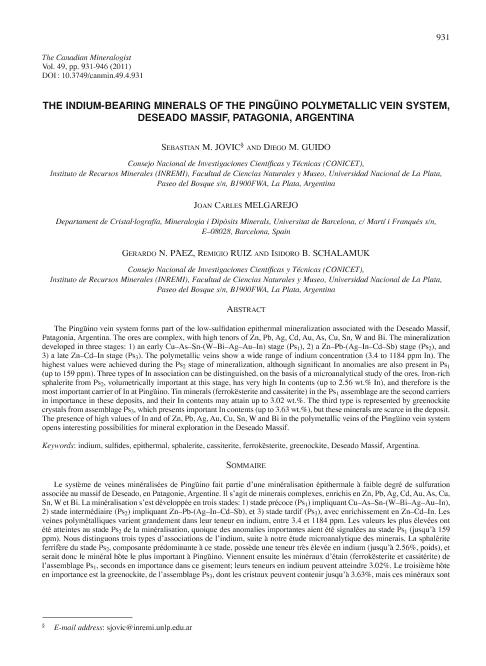Artículo
The Pingüino vein system forms part of the low-sulfidation epithermal mineralization associated with the Deseado Massif, Patagonia, Argentina. The ores are complex, with high tenors of Zn, Pb, Ag, Cd, Au, As, Cu, Sn, W and Bi. The mineralization developed in three stages: 1) an early Cu–As–Sn-(W–Bi–Ag–Au–In) stage (Ps1), 2) a Zn–Pb-(Ag–In–Cd–Sb) stage (Ps2), and 3) a late Zn–Cd–In stage (Ps3). The polymetallic veins show a wide range of indium concentration (3.4 to 1184 ppm In). The highest values were achieved during the Ps2 stage of mineralization, although significant In anomalies are also present in Ps1 (up to 159 ppm). Three types of In association can be distinguished, on the basis of a microanalytical study of the ores. Iron-rich sphalerite from Ps2, volumetrically important at this stage, has very high In contents (up to 2.56 wt.% In), and therefore is the most important carrier of In at Pingüino. Tin minerals (ferrokësterite and cassiterite) in the Ps1 assemblage are the second carriers in importance in these deposits, and their In contents may attain up to 3.02 wt.%. The third type is represented by greenockite crystals from assemblage Ps3, which presents important In contents (up to 3.63 wt.%), but these minerals are scarce in the deposit. The presence of high values of In and of Zn, Pb, Ag, Au, Cu, Sn, W and Bi in the polymetallic veins of the Pingüino vein system opens interesting possibilities for mineral exploration in the Deseado Massif. Le système de veines minéralisées de Pingüino fait partie d’une minéralisation épithermale à faible degré de sulfuration associée au massif de Deseado, en Patagonie, Argentine. Il s’agit de minerais complexes, enrichis en Zn, Pb, Ag, Cd, Au, As, Cu, Sn, W et Bi. La minéralisation s’est développée en trois stades: 1) stade précoce (Ps1) impliquant Cu–As–Sn-(W–Bi–Ag–Au–In), 2) stade intermédiaire (Ps2) impliquant Zn–Pb-(Ag–In–Cd–Sb), et 3) stade tardif (Ps3), avec enrichissement en Zn–Cd–In. Les veines polymétalliques varient grandement dans leur teneur en indium, entre 3.4 et 1184 ppm. Les valeurs les plus élevées ont été atteintes au stade Ps2 de la minéralisation, quoique des anomalies importantes aient été signalées au stade Ps1 (jusqu’à 159 ppm). Nous distinguons trois types d’associations de l’indium, suite à notre étude microanalytique des minerais. La sphalérite ferrifère du stade Ps2, composante prédominante à ce stade, possède une teneur très élevée en indium (jusqu’à 2.56%, poids), et serait donc le minéral hôte le plus important à Pingüino. Viennent ensuite les minéraux d’étain (ferrokësterite et cassitérite) de l’assemblage Ps1, seconds en importance dans ce gisement; leurs teneurs en indium peuvent atteindre 3.02%. Le troisième hôte en importance est la greenockite, de l’assemblage Ps3, dont les cristaux peuvent contenir jusqu’à 3.63%, mais ces minéraux sont rares dans ce gisement. La présence de valeurs élevées en In et en Zn, Pb, Ag, Au, Cu, Sn, W et Bi dans les veines polymétalliques du système de Pingüino présente des possibilités intéressantes pour l’exploration minérale dans le massif de Deseado.
The indium-bearing minerals of the Pingüino polymetallic vein system, Deseado Massif, Patagonia, Argentina
Jovic, Sebastian Miguel ; Guido, Diego Martin
; Guido, Diego Martin ; Melgarejo, Joan Carles; Paez, Gerardo Nestor
; Melgarejo, Joan Carles; Paez, Gerardo Nestor ; Ruiz, Remigio
; Ruiz, Remigio ; Schalamuk, Bernardo Isidoro
; Schalamuk, Bernardo Isidoro
 ; Guido, Diego Martin
; Guido, Diego Martin ; Melgarejo, Joan Carles; Paez, Gerardo Nestor
; Melgarejo, Joan Carles; Paez, Gerardo Nestor ; Ruiz, Remigio
; Ruiz, Remigio ; Schalamuk, Bernardo Isidoro
; Schalamuk, Bernardo Isidoro
Fecha de publicación:
08/2011
Editorial:
Mineralogical Association of Canada
Revista:
Canadian Mineralogist
ISSN:
0008-4476
Idioma:
Inglés
Tipo de recurso:
Artículo publicado
Clasificación temática:
Resumen
Archivos asociados
Licencia
Identificadores
Colecciones
Articulos(CCT - LA PLATA)
Articulos de CTRO.CIENTIFICO TECNOL.CONICET - LA PLATA
Articulos de CTRO.CIENTIFICO TECNOL.CONICET - LA PLATA
Citación
Jovic, Sebastian Miguel; Guido, Diego Martin; Melgarejo, Joan Carles; Paez, Gerardo Nestor; Ruiz, Remigio; et al.; The indium-bearing minerals of the Pingüino polymetallic vein system, Deseado Massif, Patagonia, Argentina; Mineralogical Association of Canada; Canadian Mineralogist; 49; 4; 8-2011; 931-946
Compartir
Altmétricas



